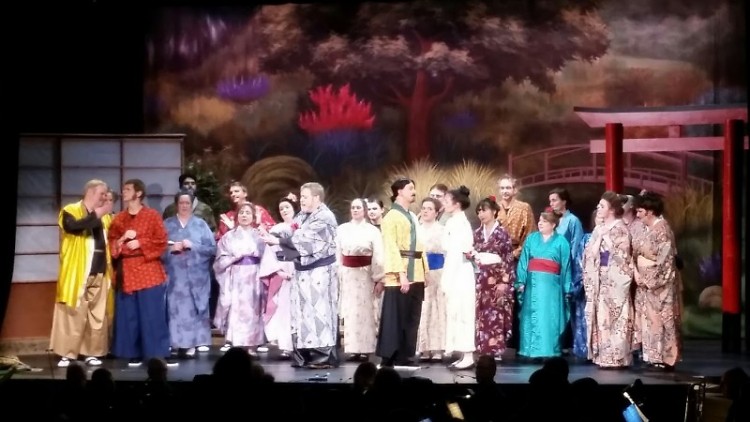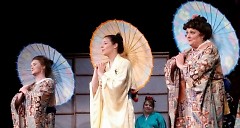What are acceptable vestiges for art to speak through?
This is the simple question that so many other questions seem to boil down to as we reflect on West Michigan Savoyards’ latest production of "The Mikado", showing this weekend at Wealthy Theatre. Those familiar with the production may be aware that controversy has followed its appearance on stages throughout the country within the last few decades, as cultural awareness of systemic racism, particularly as it affects Asian-Americans, has secured a more prominent place in the public eye. In particular, its use of white actors in yellowface has drawn heavy criticism. A 2014 production by the Seattle Gilbert and Sullivan Society received a great deal of public push-back, and in the fall of 2015, the New York Gilbert & Sullivan Troupe cancelled its production following outcry from the Asian-American community.
"The Mikado" premiered at the Savoy Theatre in London in 1885, and is arguably the most popular of Gilbert and Sullivan’s collaborative theater efforts. At its debut, it was revolutionary in the way it utilized a fictitious Japanese setting as a lens through which to critique Victorian society. The libretto was penned just as British society was beginning to encounter Japanese culture, namely through the exhibition of a Japanese village on display in London at the time of the show’s initial run. It has been argued that the theatricality of the show was, at its inception, a tribute on the part of Gilbert and Sullivan to the growing British appreciation of the Japanese aesthetic during that era.
"The Mikado’s" plot revolves around a romantic farce involving a self-aggrandizing town official, his young, beautiful ward, a noble son traveling in disguise, and the older woman who has fallen for him and resolves to find him so they can be wed. Over-arching themes address prohibitions on public flirtation, and the circuitous and often irrational procedures by which violations of this prohibition are punished. It goes without saying that this commentary is largely anachronistic, given the thirteen decades that have passed since the show’s debut. However, during our chat before Thursday night’s performance, director Carol McAndrew sought to strengthen the show’s relevance by likening the quandary of "The Mikado’s" characters to behavioral prohibitions and regulated attire in some Middle Eastern countries today. This parallel leaves us with yet another question: Why not let both Asian Americans and Middle Eastern women speak for and represent themselves?
Despite these persistent queries, the cast put on an entertaining and lively performance. Anna Cormier and Jim DeVries, Yum-Yum and Pooh-Bah, respectively, were two standouts vocally, delivering solid, steady, and quirky performances. Steve Marouchoc conjured a convincingly unctuous and oily Ko-Ko, and Jen Kouw, as a relentlessly domineering Katisha, was delightfully bizarre. Some of the best musical moments were the quintets of “Brightly Dawns Our Wedding Day” and “See How The Fates Their Gifts Allot,” showcasing the vocal agility required to perform The Mikado’s exacting libretto. Watching the cast’s earnest delivery, it was almost tempting to overlook the many problematic factors inherent to the performance.
Kimonos, fans, and sock-and-sandal-clad feet were certainly in evidence; mostly absent was any overtly “Japanese” imitation. However, the female chorus’ mincing steps, ubiquitous fan dances, and the stereotypically “Asian” male posturing during the opening scene leave no doubt as to the fact that this show is married to its mimicry of a fantastical, yet firmly rooted in the Western gaze, Japanese culture.
Director McAndrew clearly exercised a certain degree of effort to modernize parts of the libretto. Nods were made to the current political climate in America, including references to “The Donald” and to “the psuedo-socialist,” as well as a truly baffling and unexpected cameo by Hillary Clinton, clad in a pointedly appropriate royal blue skirt-suit. There was musical commentary on texting, fist pounding, and a rather clumsily-integrated snub toward women who drink boxed wine. The audience responded with obliging chuckles. But aside from these few token acknowledgements, no effort was made to truly confront the ongoing and increasing objections of Asian-Americans, and particularly Japanese-Americans, to the generalized “Oriental” pageantry which pervades the production.
The crux of the matter is yet another question: how can modern companies like West Michigan Savoyards reframe the show in a current and respectful context? Furthermore, is the dedication to memorializing the work of Gilbert and Sullivan an adequate bulwark against the myriad protests to this arguably dated and unaware portrayal of, for lack of a better word, “Asian-ness?” Director McAndrew was explicit in stating that the cast was meant to be perceived as a group of British people pretending to be Japanese, the “play within a play” device meant to add a second degree of separation to the uncomfortable phenomenon of white actors playing Asian characters. But does this work, or does it simply point up the production's racist politics?
At its most basic, the plot requires little from its setting in the fictitious town of Titipu to stand alone as a political satire masquerading as romantic shenanigans. It begs the question: is all this panoply of racial mockery really necessary to preserving the original message of the production? Must we watch white women in kimonos titter modestly behind their hands in what is clearly recognizable as a “Japanese” gesture? Wouldn’t it be more progressive and in keeping with the original sentiments of Gilbert and Sullivan to tip the cap to their satirical genius by updating the show to be more currently clever? And less pandering to a bygone era’s predilections for humor?
At the beginning of the performance, director McAndrew addressed the audience and, in a quaint nod to her roll, had them practice their laughter so as to be fully prepared for the hilarity of the performance. But we’re left wondering who’s laughing, and why? Is the joke worth the offense? Is there any reason to continue promoting the deliberate misrepresentation of an entire culture, including the preservation of the widely appreciated material of Gilbert and Sullivan? Or is it yet another case of tone-deafness on the part of a white-dominated performance culture?
Ultimately, we’re left with more questions than this review can adequately tackle. At what point should we, as a theatre community, cease nurturing systemic racism in honor of upholding the tradition of long-lived but culturally outdated productions? Does nostalgia excuse a willful ignorance of the far-reaching impact of art imitating discrimination? And, at its most basic, does the glorification of a white culture appropriating a non-white culture for the sake of critiquing its own political foibles really carry enough purpose to excuse the marginalization of the culture it appropriates?
We’d like to propose a challenge to future directors of West Michigan Savoyards; to explore ways in which they can work to bring this production, with all its attendant beloved theatricality and its phenomenal staying power, into the twenty-first century. We look forward to seeing further productions by this company, and hope they will retain an open mind and a creative, adaptable attitude toward meaningful critiques of their own culture, time and place.
Edit: Our apologies to director McAndrew for the errant "s" - the misspelling has been corrected.
The Mikado at Wealthy Theatre
The Mikado will play at Wealthy Theatre this Friday, April 22nd at 1 p.m. and 8 p.m., Saturday, April 23rd at 8 p.m., and Sunday, April 24th at 2:30 p.m.
Tickets: http://www.grcmc.org/node/10185/west-michigan-savoyards-presents-the-mikado
The Rapidian, a program of the 501(c)3 nonprofit Community Media Center, relies on the community’s support to help cover the cost of training reporters and publishing content.
We need your help.
If each of our readers and content creators who values this community platform help support its creation and maintenance, The Rapidian can continue to educate and facilitate a conversation around issues for years to come.
Please support The Rapidian and make a contribution today.

